Gigabyte F2A85X-UP4 Review – Are PowIRStages Needed with Trinity?
by Ian Cutress on December 14, 2012 12:00 PM EST- Posted in
- Motherboards
- Gigabyte
- FM2
- A85X
Gigabyte F2A85X-UP4 In The Box
If the previous FM2/A85X packages are anything to go by, we should not expect much in the Gigabyte box. So far the previous packages have all contained four SATA cables, with the odd one or two adding extra connectors to aid the Front Panel connector placement.
In the Gigabyte F2A85X-UP4, we get:
Driver Disk
Manuals
Rear IO Panel
Six SATA cables
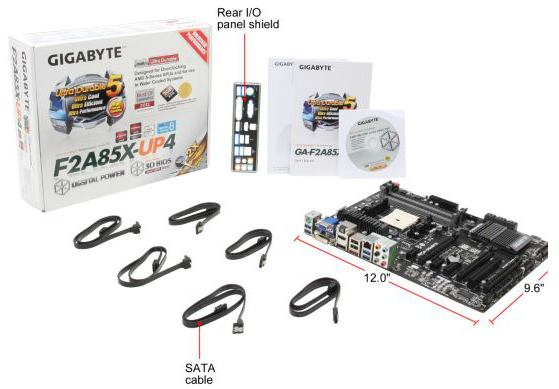
Gigabyte has a one-up on the other boxes so far, by virtue of two extra SATA cables. With a chipset that gives out eight SATA ports, having six in the box is a nice touch.
Gigabyte F2A85X-UP4 Software
The software stack at Gigabyte HQ is in a little bit of flux right now. On one hand they have software which has been part of the package for a few iterations, which we will examine later. On the other are extra bits of software that do not come on the install CD, but are available to download through the website. In an ideal world, the software would all be on the disk, and have an automatic updater included to download the latest releases of drivers and all software.
The Driver CD itself is easy to use – the first screen gives an option of deselecting software (such as the anti-virus) and an option to install everything.
After the driver and non-Gigabyte software install, another dialog appears asking if the user would like the Gigabyte utilities installed. Technically this should be singular, as only one utility is installed – EasyTune6.
EasyTune6
EasyTune has been with us in various guises over the years. The latest version is number six, which has been part of the main Gigabyte software package for at least two years now. The premise of EasyTune is simple – a single interface in order to get all the information about the system, perhaps do some overclocking, adjust some fan settings and monitor what is going in under the hood. While it is a nice goal, it leaves a little to be desired in terms of implementation.
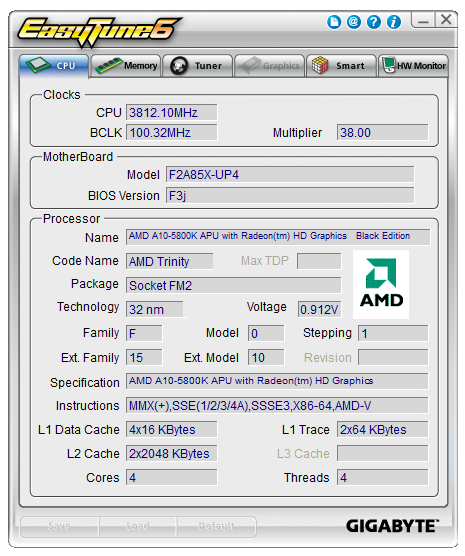
One element lacking in the land of Trinity processors with EasyTune6 is the options relating to automatic overclocking. It has been customary for Gigabyte to include several overclocking options in EasyTune for users to click one button and settings to be applied. No such luck – the only overclocking through ET6 is via the manual options. Users can adjust the BCLK, memory strap, base and turbo multipliers and also the voltages throughout the various menus.

We can also control the fans in ET6, and this time we actually get a chance to play around with a gradient. This is only a two-point gradient, where the y-axis says RPM and the x-axis gives temperature. What is interesting is that below this are the actual numbers, whereby it says ‘Fan PWM, 35% (RPM)’. This is an erroneous statement – fan speeds are not directly proportional to the power applied. Typically a fan will start at a minimum RPM on low power, then after a threshold it will start to rise linearly. But not in the fashion that Gigabyte’s software suggests.
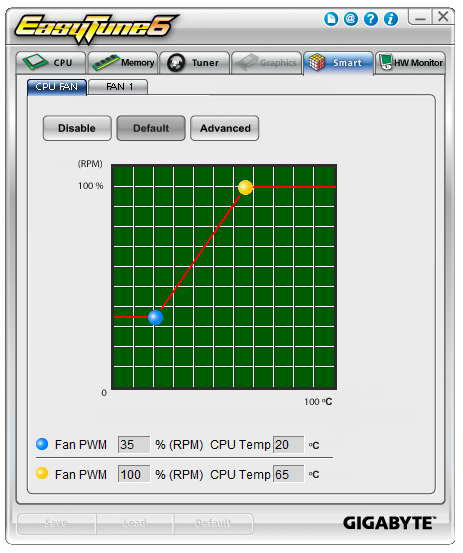
The final part of ET6 is the monitoring tool. This gives a small graphical output for voltages, although the scale of the graph could be frustrating as it tries to take into account low voltages such as the CPU along with the +12 V rail in the same graph. The default scan time of 3 seconds causes concern in our DPC Latency test, whereby we would score over 1000 microseconds when ET6 was running. This could lead to audio issues when recording, thus it is recommended to disable ET6 when audio processing.
Gigabyte F2A85X-UP4 Overclocking
Methodology:
Our standard overclocking methodology is as follows. We select the automatic overclock options and test for stability with PovRay and OCCT to simulate high-end workloads. These stability tests aim to catch any immediate causes for memory or CPU errors.
For manual overclocks, based on the information gathered from previous testing, starts off at a nominal voltage and CPU multiplier, and the multiplier is increased until the stability tests are failed. The CPU voltage is increased gradually until the stability tests are passed, and the process repeated until the motherboard reduces the multiplier automatically (due to safety protocol) or the CPU temperature reaches a stupidly high level (100ºC+). Our test bed is not in a case, which should push overclocks higher with fresher (cooler) air.
Automatic Overclock:
As mentioned above, the Gigabyte F2A85X-UP4 has no automatic overclocking methods. I am as shocked as you are, but the current Gigabyte policy is to only offer methods through ET6. As ET6 does not have any, all overclocking must be manual.
Manual Overclock:
Using the BIOS, we took a similar approach to overclocking as with the other A85X motherboards tested with this processor. We start at 1.4 volts on the CPU in the BIOS and a CPU multiplier of 44x for all cores. Here are the results:
At 4.4 GHz we required a BIOS setting of 1.550 volts, which gave a load voltage in the OS of 1.488 volts. This passed OCCT and gave a PovRay score of 737.96.
At 4.5 GHz we required a BIOS setting of 1.650 volts, which gave a load voltage in the OS of 1.584 volts. This passed OCCT and gave a PovRay score of 754.96.
At 4.6 GHz, no setting was OCCT stable all the way up until 1.750 volts. This is higher than we have pushed any of our Trinity processors in other reviews, and thus I was uncomfortable pushing it further.


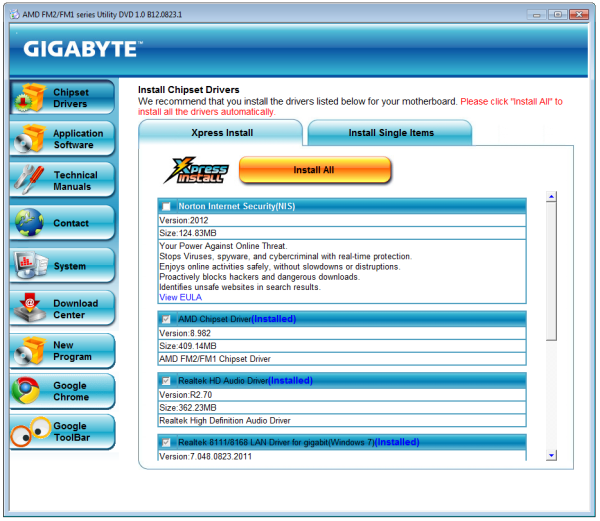






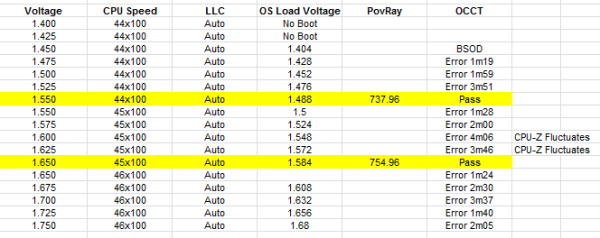








25 Comments
View All Comments
ssj3gohan - Friday, December 14, 2012 - link
It's funny that you should ask, because you're totally right: inside is a miniscule bit of silicon with a - by modern standards - very old-fashioned package. But the reason it's so small is simply legacy and second (and third, and fourth) suppliers. Many companies make these (and have tens of millions in stock laying around, the date code on the SIO chip on one of my july '12 boards reads second week of 2010!) and they are mostly interchangeable between mfgrs. If one runs out of stock or asks a fraction of a cent more, they can shop around at the next corner for a better deal without having to respin the board.And also: on any motherboard there is a ridiculous amount of space. ATX boards rarely have better than 40% fill factor, you can fit at least twice as much stuff on there. There is no need to use smaller chips.
The reason not to ditch these chips at all is because it allows for any sort of high-voltage power/interface stage to be delegated to this cheap external chip. It's a huge pain to build 3.3 or even 5V buffers into a mostly 1.05V chip (i.e. chipsets), especially if they also need to have proper ESD protection circuitry. That's stuff that takes up a lot of expensive silicon area. Just having one chip that interfaces everything high voltage hugely simplifies the design of a motherboard. Note that it's not just legacy parallel/serial port connections, but also LEDs, fan control, measuring voltages and even power conversion interfacing that these chips can do.
klmccaughey - Sunday, December 30, 2012 - link
Yup, exactly. They probably have a lot of that silicon not standard transistors / circuitry, but more for voltage and power regulation. It's a bit like a 1/4 inch bolt - industry standard and no need to change it.ssj3gohan - Friday, December 14, 2012 - link
Haha, I see you responded to the complaints of a couple of people on power consumption (among which I have also had my say in the comments of one of your earlier reviews), but your response is not entirely satisfactory IMO.You say that it's the relationship between the numbers that we should look at to get an idea of which is more efficient than the other, but the relationship is not linear and not indicative of what a consumer will get! I build extremely efficient computers (5.4-15W idle, typically) and these absolute differences in power consumption still carry over to low power computers as well: employing a 10W more power hungry motherboard in a 15W computer means my efficiency goes down the drain, whereas on a 150W idle dual-graphics monster PC it doesn't matter one bit. What people need to know is the individual power draw (or losses) of components, not a number that is obfuscated by many, many other uncharacterized components with little or no links to information on their share of the power consumption pie - or influence on power consumption on this particular part!
Second, I know from my experience with these boards that these power consumption numbers mean not a damned thing without the context of which BIOS/EFI settings you used, as well as how well you installed current drivers and such things. Or even what services are running at the time of measurement. One faulty setting can absolutely ruin power consumption, it's a sad fact of life.
We, as readers, have absolutely no way of comparing your findings to anyone else, probably not even to your own other reviews. The only way to have robust power consumption figures is to have DC measurements of isolated system components, with known settings (e.g. 'stock bios F1, no modifications, running windows 8 fully idle, no active background services') and verified use states (i.e. 'system running in ACPI C2'). It's a lot to ask all at once, but waving away the extreme nonorthogonality of your measurements is not the direction I want to see the increasingly important segment of power consumption to go.
Parhel - Friday, December 14, 2012 - link
How is power consumption becoming "increasingly important" for ATX desktop motherboards? I'm not seeing it.klmccaughey - Sunday, December 30, 2012 - link
It is important for always on devices. If you are anything like me you have a lot of computer equipment about the house. I had the guy come round to do an Electricity provider switch-over and he did a few measurements and calculation for me. The computer power added up to a hell of a lot more than I expected.Energy prices are rising world-wide and there is a big push on in many sectors to get power consumption down and stop wasting so much. Initially I was a bit sceptical, but the more oil/gas goes up each year the more I am taking it seriously.
If this is to be used as an always on media server or Raid board, I would actually be checking to make sure it isn't a power hog.
ggathagan - Friday, December 14, 2012 - link
As you clearly understand, it IS a lot to ask all at once.The granularity you desire in this particular area of motherboard testing is well outside of the scope of these reviews, especially when factoring in all of the variables that you mention.
There are time limitations, both on the part of the reviewer, as well as the part of the manufacturer.
If you feel this particular arena of testing is so important, might I suggest starting your own site and performing reviews that focus on the details of power consumption you consider to be important?
Or perhaps you could ask an existing review site if they would be interested in beginning a partnership that would allow you to produce a review addendum that covers these details on the boards that they've reviewed.
I would think that power efficiency would be of particular interest to sites that focus on HTPC systems or sites that focus on low noise systems.
Just as Anandtech has branched out over the years with regard to the areas of technology it covers, I can also see reviewing various products with this sort of focus in mind.
This is especially true as the desire to reduce the size of systems tends to run into limitations due to power consumption and, by extension, heat production.
ssj3gohan - Friday, December 14, 2012 - link
I kind of do already have a site on these subjects, although I don't do reviews, rather I push on the extremes of PC power consumption: http://bit.ly/Of2jrHOn the face of it, I don't actually ask for that much extra testing, I mostly ask for reviewers (in general) to publish materials that show that they understand power consumption completely and have done the things that need to be done to get consistent, comparable results. This basically means understanding power states, measuring power consumption at true steady-state and verifying that all power saving methods are operating as they should. Only then can you get truly comparable power consumption results.
The bit that is really hard to do is to completely isolate motherboard DC power consumption and losses. I don't expect this to happen anytime soon, but at least the DC power measurement can be done. That alone would be a big, big improvement.
Even for ATX boards, power consumption is an issue for enough people and is something that has a place in a proper in-depth review. But these power consumption measurements should really mean something, and what I am seeing right now is measurements that can probably go either way depending on what the reviewer did - which is a black box to me.
Tech-Curious - Friday, December 14, 2012 - link
Fascinating blog -- and amazing work on those custom builds of yours.That said, I think you're more concerned about power efficiency than ... uh, anyone else in the world. And you're probably more knowledgeable about computer power consumption than most anyone who visits this site, including the people who write reviews for it.
None of which is to say that Anandtech (and similar hardware-review sites) couldn't or shouldn't try to improve their power measurements, but we must acknowledge that the audience for Anand's reviews isn't primarily concerned with power measurements. Power consumption matters, but it isn't the meat and potatoes of the meal here; it's more like a side salad.
klmccaughey - Sunday, December 30, 2012 - link
Pwned ;)popej - Friday, December 14, 2012 - link
Your results for THD+N look bad. Most probably are limited by input quality. Audio input on motherboard usually isn't used for anything more demanding then simple microphone, so its quality isn't important for manufacturer. Would be more interesting to measure output only, using good reference audio card or USB adapter.Result dependency on frequency isn't right either. Probably something is wrong in configuration, maybe drivers do poor resampling of audio signal.